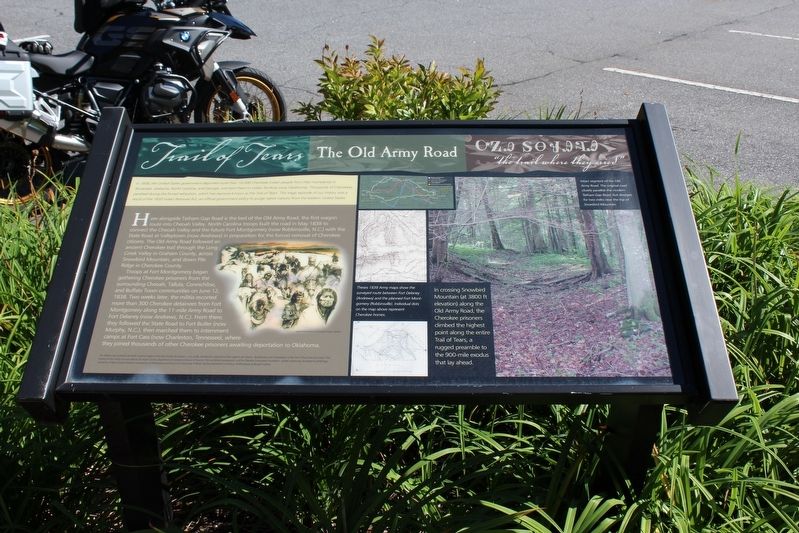Andrews in Cherokee County, North Carolina — The American South (South Atlantic)
The Old Army Road
Trail of Tears
In 1838, the United States government deported more than 16,000 Cherokee Indian people from their homelands in Tennessee, Alabama, North Carolina, and Georgia, and sent them to Indian Territory (now Oklahoma). Thousands of Cherokees perished during the forced relocation, which has become known as the Trail of Tears. This tragic episode of our history was a result of the 1830 Indian Removal Act, an official government policy to purge native nations from the eastern United States.
Here alongside Tatham Gap Road is the bed of the Old Army Road, the first wagon route into Cheoah Valley. North Carolina troops built the road in May 1838 to connect the Cheoah Valley and the future Fort Montgomery (now Robbinsville, N.C.) with the State Road at Valleytown (now Andrews) in preparation for the forced removal of Cherokee citizens. The Old Army Road followed an ancient Cherokee trail through the Long Creek Valley in Graham County, across Snowbird Mountain, and down Pile Ridge in Cherokee County.
Troops at Fort Montgomery began gathering Cherokee prisoners from the surrounding Cheoah, Tallula, Connichiloe, and Buffalo Town communities on June 12, 1838. Two weeks later, the militia escorted more than 300 Cherokee detainees from Fort Montgomery along the 11-mile Army Road to Fort Delaney (now Andrews, N.C.). From there, they followed the State Road to Fort Butler (now Murphy, N.C.), then marched them to internment camps at Fort Cass (now Charleston, Tennessee), where they joined thousands of other Cherokee prisoners awaiting deportation to Oklahoma.
(captions)
Intact segment of the Old Army Road. The original road closely parallels the modern Tatham Gap Road, but diverges for two miles near the top of Snowbird Mountain.
These 1838 Army maps show the surveyed route between Fort Delaney (Andrews) and the planned Fort Montgomery (Robbinsville). Individual dots on the map represent Cherokee homes.
In crossing Snowbird Mountain (at 3800 ft elevation) along the Old Army Road, the Cherokee prisoners climbed the highest point along the entire Trail of Tears, a rugged preamble to the 900-mile exodus that lay ahead.
Erected by North Carolina Chapter of the Trail of Tears Association.
Topics and series. This historical marker is listed in these topic lists: Native Americans • Roads & Vehicles. In addition, it is included in the Trail of Tears series list. A significant historical month for this entry is May 1838.
Location. 35° 12.322′ N, 83° 49.799′ W. Marker is in Andrews, North Carolina, in Cherokee County. Marker can be reached from the intersection of Locust Street and County Highway 1419, on the left when traveling north. Marker is located 0,1 miles west of the intersection at the Andrews Rest Area. Touch for map. Marker is in this post office area: Andrews NC 28901, United States of America. Touch for directions.
Other nearby markers. At least 8 other markers are within 8 miles of this marker, measured as the crow flies. Konehete (a few steps from this marker); Resistance and Resurgence on Valley River (a few steps from this marker); Fort Delaney (within shouting distance of this marker); Harold H. Hall (approx. 0.3 miles away); The "Peavine" Special (approx. 0.3 miles away); Valleytown Center (approx. half a mile away); Junaluska (approx. 8 miles away); Junaluska's Distingusihed Service (approx. 8 miles away). Touch for a list and map of all markers in Andrews.
Credits. This page was last revised on September 17, 2020. It was originally submitted on September 13, 2020, by Tom Bosse of Jefferson City, Tennessee. This page has been viewed 650 times since then and 79 times this year. Photos: 1, 2. submitted on September 13, 2020, by Tom Bosse of Jefferson City, Tennessee. • Bernard Fisher was the editor who published this page.

